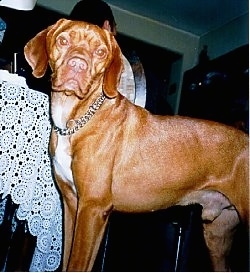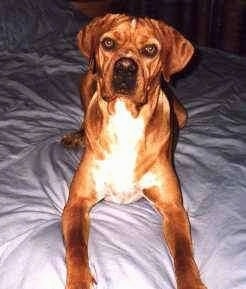
Diogo the Portuguese Pointer
The Portuguese Pointer is a compact looking dog that is square in build. Its head is square with a marked stop. The ears are triangular and hang down. The tail is often docked to half its length or two-thirds the natural length, although this is illegal in some countries. The coat is short and coarse with a more velvet fur on the ear and face. Coat colors include light brown, brown, white and brown, white and yellow and yellow.
This breed is loyal, intelligent and very energetic. Sweet and affectionate to its owner. With enough exercise they will be calm in the home. Patient, friendly, love children and are a true friend to the family. They adapt well to new situations. Socialize well at an early age and as the owner of the dog, be sure to stay mentally strong so the dog can feed from your energy to avoid timidity. Nervous humans tend to have nervous dogs because the dog can feel your emotions. If you do not provide enough mental and/or physical exercise they will become high-strung and distractible and can become neurotic and destructive. If they sense their owners are not as strong-minded as themselves they will become a bit willful as they will believe they need to be the leader of the relationship. It will bark at suspicious noises, but it is not a watchdog. Hunting instincts develop early. They have an excellent nose. Puppies will start to display pointing behavior as young as 2 to 3 months old without training. These dogs are generally good with other pets and are not usually dog-aggressive.
Height: Males 20–24 inches (51–61 cm) Females 19–22 inches (48–56 cm)
Weight: Males 44–60 pounds (20–27 kg) Females 35–49 pounds (16–22 kg)
Prone to hip dysplasia and other joint related problems. Keep ears clean to prevent ear infections. Some lines have had albino pups born.
These dogs are not recommended for apartment life. They are moderately active indoors and do best with acreage.
This is a high energy working dog with remarkable hunting instincts. Energetic and tireless, they need vigorous exercise to prevent extreme indoor restlessness. They need to be taken on a daily, brisk, long walk, jog. While out on the walk the dog must be made to heel beside or behind the person holding the lead, as instinct tells a dog the leader leads the way, and that leader needs to be the human. Teach them to enter and exit door and gateways after the humans. When the dog is taught to work as a hunting dog it must be taught the difference between when it is time to work and when it is not. When it is not time to hunt, the dog should be respectfully heeling on a leash for the handler.
About 12-14 years
About 5 to 8 puppies
The smooth coat of the Portuguese Pointer is very easy to groom. Brush regularly with a firm bristle brush and bathe only when necessary. A rub with a piece of toweling or chamois will leave the coat gleaming. Check the feet, especially after the dog has been exercising or working. Dry the dog thoroughly after hunting to prevent chilling. Ears should be checked regularly. This breed is an average shedder.
Portugal
Gun Dog

Diogo the Portuguese Pointer